If I told you we were sitting down to play a game in which you’d be collecting toothbrushes, coffee mugs, house keys, and toasters while fishing for ideas, mining energy and memory traces—oh, and building a disconnected pipeline, you might say the game is lacking in focus.
If just before I told you about the game I showed you artist Matt Dixon’s Twitter feed, which is full of images from his creative universe—called Transmissions—you might see the situation with a fresh perspective. Matt Dixon recently Kickstarted an eighth volume of beautifully crafted work in the Transmissions world, which features a collection of quirky robots who all seem to be reminiscent of something they’ve never had. I can’t help but think of Wall-E, though the comparison is not entirely fair. If I’m being honest, I find Matt Dixon’s creations even more emotionally engaging.

Shifting gears: Transmissions, now a board game from Adam West (Ninjato, Wizards of the Wild) and his company Crosscut Games, gives the lovable robots of Matt Dixon’s imagination a chance to stretch their legs and move about in all their idiosyncratic glory. Players share influence over four of these mechanical lonely hearts as they move around their world in search of all the random bits imaginable. The player who most effectively engages the robots wins.
An expected beauty
The action for Transmissions takes place on the big, beautiful game board that contains a rondel of fourteen spaces paired off in seven distinct areas. Each of the areas will contain something of interest to the mechanical friends, who serve as workers moving clockwise about the path. At the outset, the four adorable robots are placed randomly with at least two spaces between.

Each player receives a double-layered player board that will hold Ideas, Items, Engrams, and Energy—the stock supply that fuels the robots and drives their score. They also receive a starter Pipe tile and a deck of seven cards from which they will keep a running hand of three. Four of the cards hold images of the robots, while the other three hold either two or three images indicating some of the seven areas on the board.
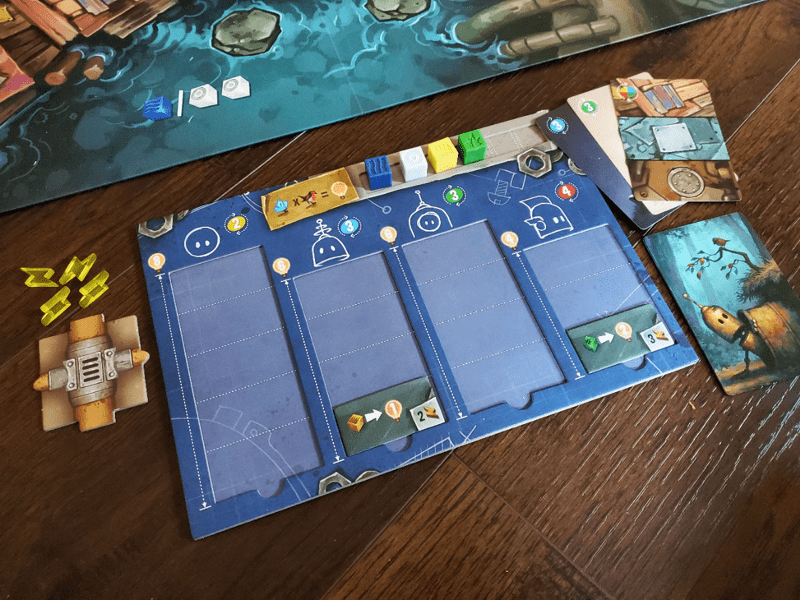
A player turn consists of choosing one of the cards from the hand of three to play. If a robot is chosen, that robot moves at least one space but up to the number indicated on the card (and the player board) before interacting with the space. If a location card is played, a robot currently in one of the played locations may then move in a similar fashion before interacting. Robots may not occupy the same space and no action is mandatory. Engrams—memory traces represented as colored acrylic cubes—and acrylic lightning Energy are the game’s currency and are acquired at the Lake, Meadow, and Power Station areas. Transmissions is a constant stream of materials in and materials out, exchanging cubes and bolts for various enhancements and scoring possibilities.
Ideas, which come from the Scrap Yard, are game-breaking enhancements that are applied to one of the robots via the player board. Once applied, that robot then exercises the ability for the rest of the game. Possibilities include bonus Energy or Engrams in various circumstances, extra movement, reverse movement and many more. On the player board, each robot has a fixed number of spaces to hold Ideas and Items.
Items are broken-down everyday human objects—balloons, mittens, radios, toy trucks—that appeal to the robots’ inexplicable sensibilities. These objects are purchased in the Town and placed into the player board as well, taking up two slots apiece. Each Item is part of a set which becomes more lucrative as matching pieces are added.
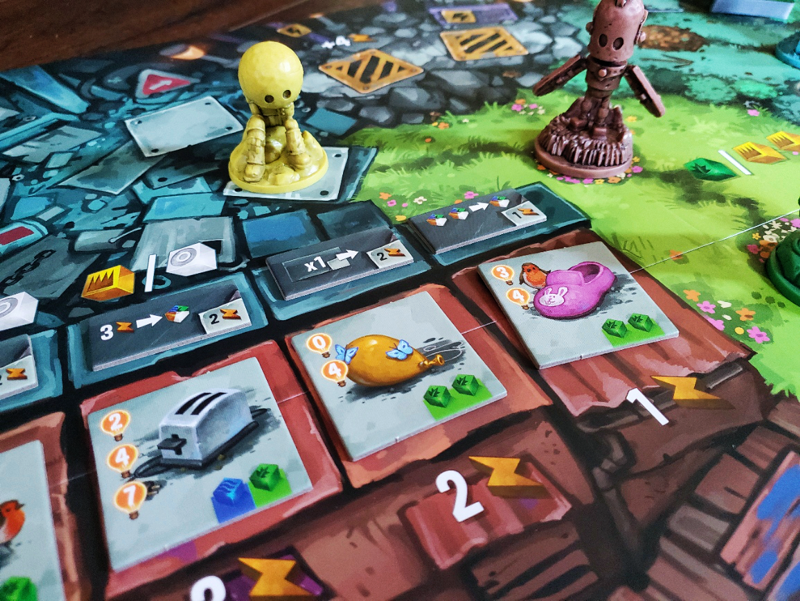
Items and Ideas, which are lined up side by side on the board, come with a dirty catch. When either an Item or an Idea is purchased, the token in the corresponding space is discarded before the remaining pieces slide down and the empty spaces replenished. Buying that trucker cap will cause the sweet exchange ability to disappear. Every time a new Idea/Item pair is revealed, it comes with the painful knowledge that only one will be purchased before the other fades into oblivion. The battle lies in racing to get the best pieces first.
Across the board, players are purchasing combinations of strange Pipe tiles that assemble like a puzzle beside the player board. At the game’s end, players score the longest continuous run of pipe stemming from their starter piece, plus each Pipe carries a point value all its own. Pipes can also be flipped rather than installed for fewer points if they do not fit, though I’ve yet to see anyone do this outside the occasional desperation of the game’s final turn.
The Forest contains a deck of cards with one-off abilities and enhancements that become immediately available and can be played at any time during a turn. As a side consideration, each of the Forest cards contains a number of acorns at the bottom. The player with the lowest number of acorns at the end of the game—provided they have at least one—gets a modest bonus.
Play continues until either the Ideas/Items cannot be replenished, a stack of Pipe tiles disappears, or someone fills their player board to capacity. The last whimsical bit of scoring comes by multiplying the Birds by the Butterflies which are found at random on some of the purchased tiles. This is a strategy all its own, but these flying ones can become quite the cutthroat business, a hidden gem revealed on the way to the scoresheet.
An unexpected exploration
I am not typically a solo player, but I was intrigued by the rules so I gave it a shot.
Players battle against Harvey, the pooka who attempts to steal away victory. Harvey participates by utilizing the three unused decks. Each turn, if his drawn card is a robot, the robot moves its maximum number of spaces. If his draw is a location, every location containing a robot moves, often resulting in multiple actions—sometimes by the same robot.
The solo affair differs in resource management because Engrams and Energy start not from a general supply but from a fixed count on the board. With every purchase comes the decision to place the various payments back onto the board—where they might eventually incur an endgame penalty—or in the supply. The tension here rises from the fact that the board resources are only replenished through Harvey’s unpredictable movements. If his movements are benevolent, Engrams are a-plenty, but if not, the much-needed pickings can be quite slim, leading to an adjustment in strategy. Sometimes you really needed that blue Engram he left in the Lake, but other times you don’t need the nine yellow Engrams he so generously left in the Meadow, awakening a sudden desire to spend yellow.
Harvey moves about, adding resources and removing Ideas, Items, Forest cards, and Pipes and generally moving in and out of your way. He becomes a robotic sand timer, whisking away everything that brings the endgame nigh and setting you up for resource penalties. His scoring mimics the human rubric, with a few exceptions designed to overcome the fact that his decisions lack good ‘ol fashioned human intelligibility.
Where I found I had the greatest advantage was with Birds and Butterflies. Because Harvey relies on the sequence of the robots on the player board to make his choices, he often leaves a more lucrative choice behind. I took to following him around and gobbling up the little multipliers, which became the difference on the scoreboard.
The Kickstarter also included four exclusive modules for play. Additional Items and Ideas are somewhat more complex, but fit seamlessly into regular play. Pipe-related Forest cards encourage the creation of specific Pipe layouts for bonus points, drawing attention more heavily to particular Pipe tiles.
The most radical module consists of two Transformers that reside in the Lake and Meadow. Rather than gobbling up Engrams in these locations, players have the option of discarding various bits from their player board for points—including Items and Ideas. This is a major shift and an opportunity to clean up Items for which no match will be made. The Transformers present two options each on the front and the back, flipping after each use. At lower player counts, we found we never needed the Transformers, but;at the higher player count where Item matching grows more difficult, they became more useful to jettison failed gambles.
An unexpected conclusion
When I spoke with Adam West earlier this year, he talked about the blessing and the challenge of bringing Matt Dixon’s world to life. Now that I have seen the finished product, I say with confidence that he is to be commended. Transmissions is a visual feast oozing charm from every corner which honors the artistic originals. The production quality is excellent. The minis immediately entered the discussion for the best I’ve ever encountered.
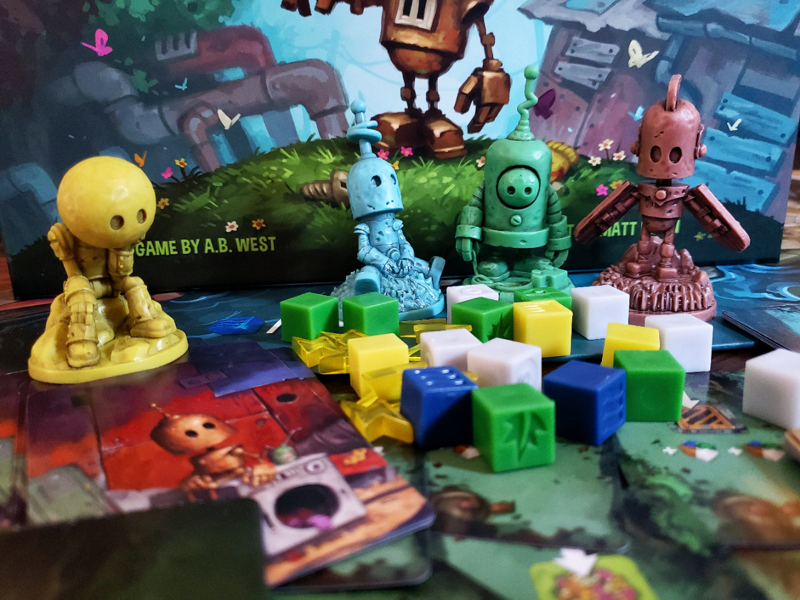
If I were to unnecessarily nitpick the components, I would wish there was some way the starter Pipe tile connected to the player board to bolster continuity. As the game stands, the Pipes often feel like a wholly separate entity. While they fit the aesthetic and the unusual ethos around the robots, they seem disconnected—it is apparent almost every time I place a tile in the chain. But it hardly seems worth holding a grudge when the game is so aesthetically pleasing overall.
Moving the robots around the board is definitely a highlight. There is a small amount of tension in managing the movement options. In each game I’ve experienced a handful of agonizing turns where I viscerally wanted to move a particular robot and couldn’t. I like that. I don’t need it every turn, but I like that the effort contains some sweaty considerations. For the most part, there is a fruitful option available among the three cards. It may come from the interaction with the landing space or the robot’s various Ideas, but it’ll come from somewhere.
And those Ideas! I thoroughly enjoy the method of upgrades in Transmissions. The four robots each have a different capacity on the player board, meaning some can hold more than others. The yellow robot, which can only move two spaces at a time without some help from Ideas, has the highest capacity—cursèd brilliant design! The red robot, which can move four spaces, has the least storage. The player board enables customization that can work hand-in-robotic-hand to produce some lovely combinations.
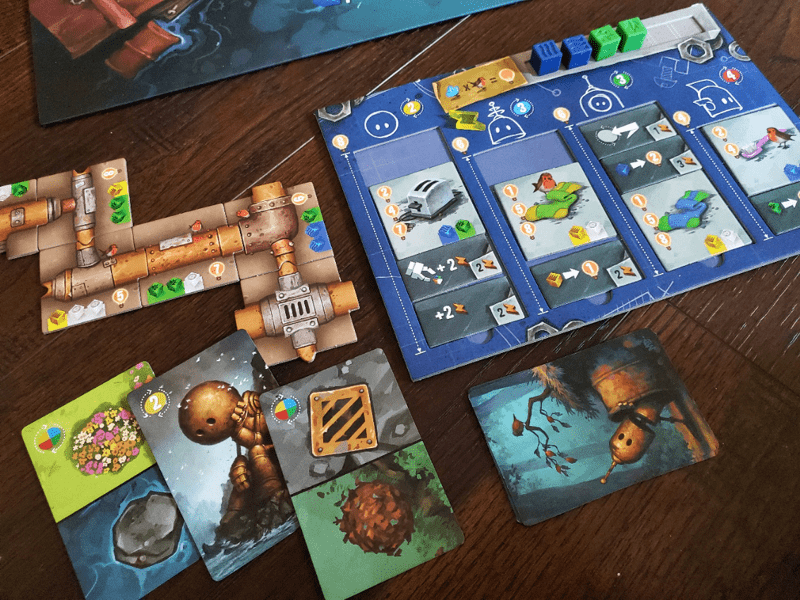
Both the Items and Ideas are separated into sets by marks on the back. The sets allow for fluid changes to the number of tiles while still guaranteeing the proper matches exist to make the game fully functional. The Items can stand alone or collect as pairs and triples. Based on the number acquired, the value of each Item increases. When a needed Item hits the board there’s a bit of electricity that leaks out into the room as players hunt to collect—or sometimes discard by the purchase of an Idea—the valuable trinket. We’ve never had a game get nasty, but we’ve known a fair amount of semi-congenial disappointment. This setup assures a fair amount of variability and keeps the game lively.
Transmissions is a pretty casual affair. The relaxed tone smacks of Tokaido, where you’ll always get something, it’s just a matter of who can best cope with the moment to pull off the right combinations on the way to the top. We’ve not experienced screams and shouts, just a tidy and subdued demeanor around the board—the robots are calming.
Almost too calming. I can’t help but feel the game is missing something. I can’t put my finger on it, but I feel its absence. The solo game proved my discontent. I was instantly impressed with the way Harvey meddles in resource management! I enjoy the extra layer of thought that the solo game provides. I’m not saying this mechanism should translate into the multiplayer outing, but the game would benefit from one additional tax on the mind—provided the game stays under an hour.
And with that comment, I’ve crossed a line. I’ve begged too much. Transmissions doesn’t waste time or space, so it’s not like I’m saying some bit or another has to go. I love the Pavlovian effect of the right Item or Idea entering the field of vision. I love the rhythmic rondel movement and the occasional lockout provided by the cards. I love the smattering of winged creatures that become so overwhelmingly enticing at all the inconvenient moments. There are so many delightful conceptual proportions in this game, it’s unfair of me to say I’m longing for more.
And yet here I am, inexplicably confused about my own opinion—many highs plagued by one blurry and nameless low.
At the end of the day, Adam West speaks my language. Wizards of the Wild is still one of my all time favorites, and Ninjato is another beloved title in our house. We expected to find joy in these new mechanical friends, and the feeling was spot on. I can’t call it the best family game out there, but it allows for some really satisfying moments. If Matt Dixon’s created world is appealing to you, Transmissions captures all the charm and the offbeat sentimentality and drives it home with an interesting experience. If you can track down a copy, I think it’s worth a play.
Just give that solo play a shot and let me know what you think.


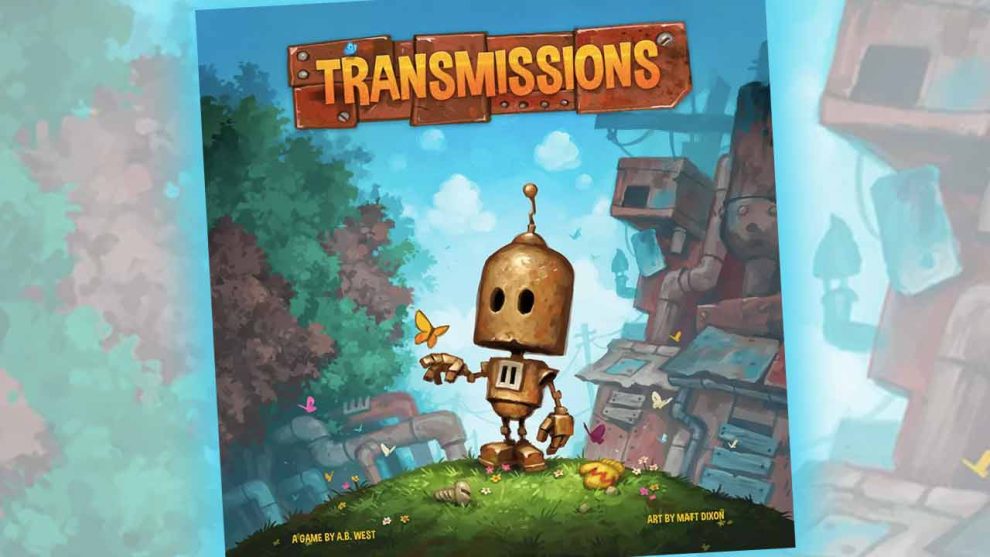









Add Comment